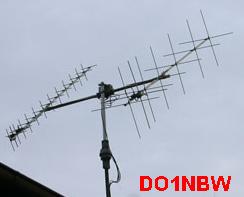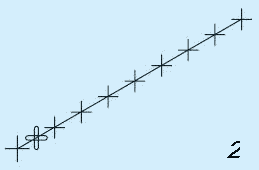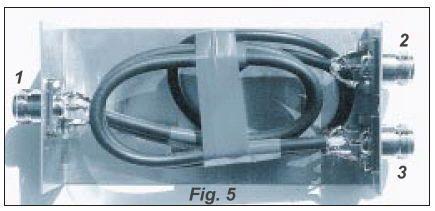Cross-Yagis for Terrestrial and Satellite Work
|
|
For two purposes a Cross-Yagi can be useful: Satellite work or if you need both vertical and horizontal polarization for terrestrial contacts. You can use two different feeding methods: Always cross polarization or switchable for vertical, horizontal an right hand cross polarization. The picture left shows 2x7-El-DK7ZB-28-Ohm-Yagis and a commercial 70cm-Crossyagi at the station of Bernd, DO1NBW. The mounting method in this case is the "cross". Use the 28-Ohm-Yagis, not the 12,5-Ohm-Yagis! |
|
Fig. 1 The "X"-mounting is recommended, if you will not switch between the polarisations, because it is difficult for this configuration to get horizontal and vertical polarisation. The antennas should be in the circular polarisation-mode.
|
|
|
|
Fig. 2 The "cross"-mounting is useful for two separate coax-cables for each plane and a phasing box (description below) for vertical, horizontal and circular polarisation. |
|
Fig. 3 It is possible to mount the two Yagis separate with two cables and the phasing box, but this needs more space. Equal lengths of coax are needed for both planes. The support-tube must be of non-conductive material! |
|
|
|
Fig. 4 The circuit for circular polarisation |
For this box you need separate coax cables from the horizontal and vertical plane with exact the same length. Four options can be realized:
1. Vertical polarisation with the cable of the vertical plane of the Yagi
2. Horizontal polarisation with the cable of the horizontal plane of the Yagi
3. Right hand circular polarisation: Horizontal plane to connector 1, vertical to connector 2, to station connector 3
3. Left hand circular polarisation: Horizontal plane to connector 2, vertical to connector 1, to station connector 3
|
Fig 5 The box with the phasing and matching cables. Use N-Connectors! |
|
|
|
Fig. 6 Circuit for right-hand circular polarisation The horizontal dipole is connected to the vertical dipole with a phasing line of a quarter-wave cable of 50-Ohm-coax. At this point the impedance is 25Ohm, which is transformed to 50 Ohm again with two parallel 75-Ohm-quarter-wave cables. It is possible to run with two cables from each plane to the station with the box for circular polarisation (Fig. 4). |
|
Bernd, DO1NBW mounting his Yagis |
|






